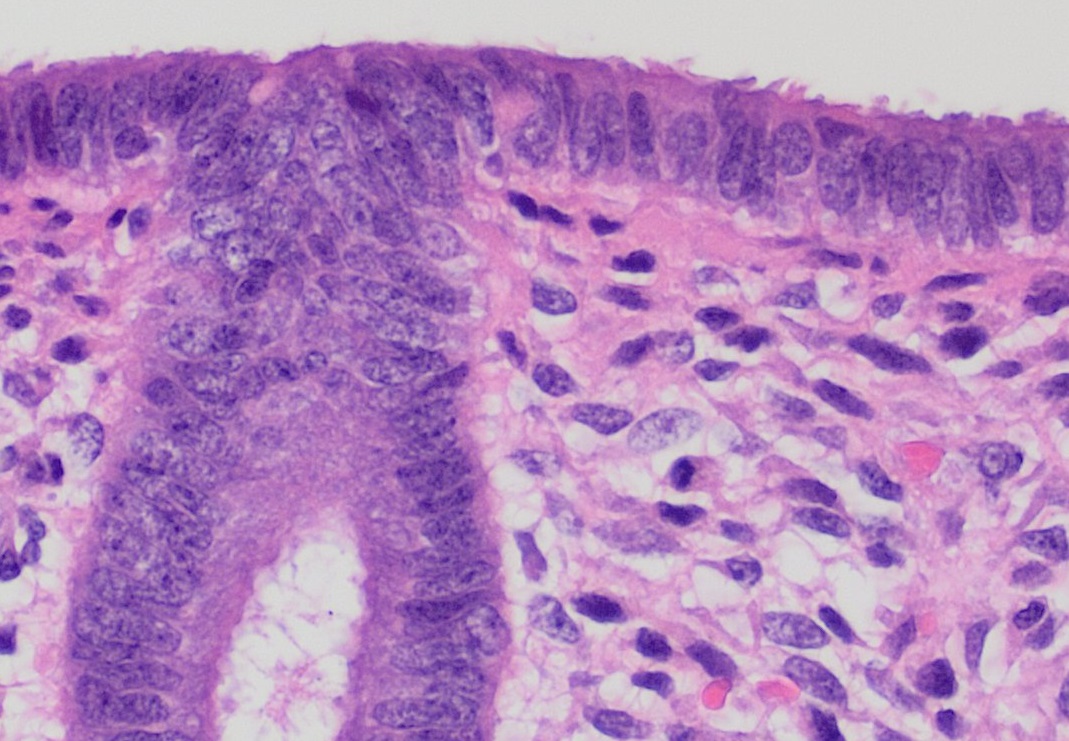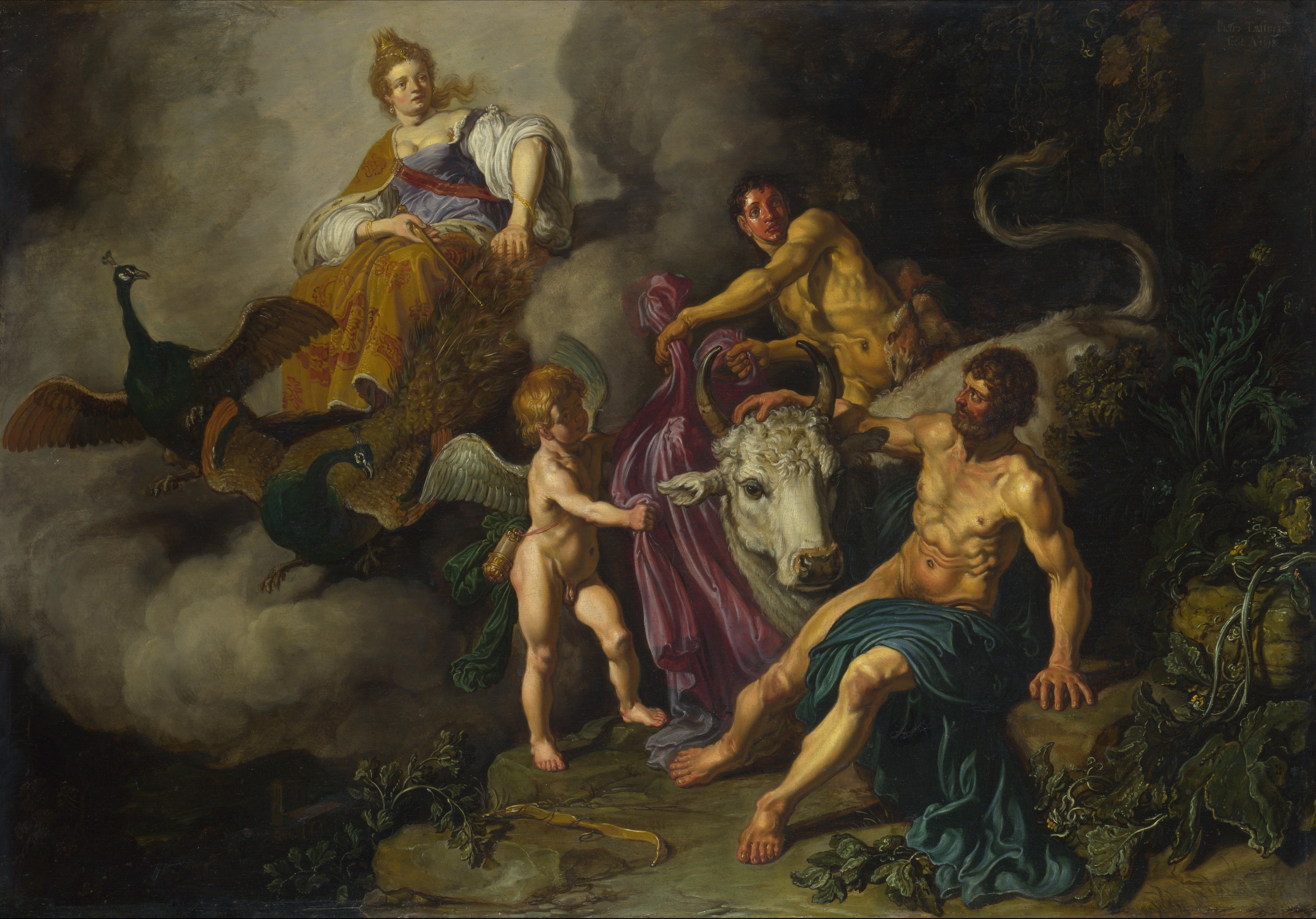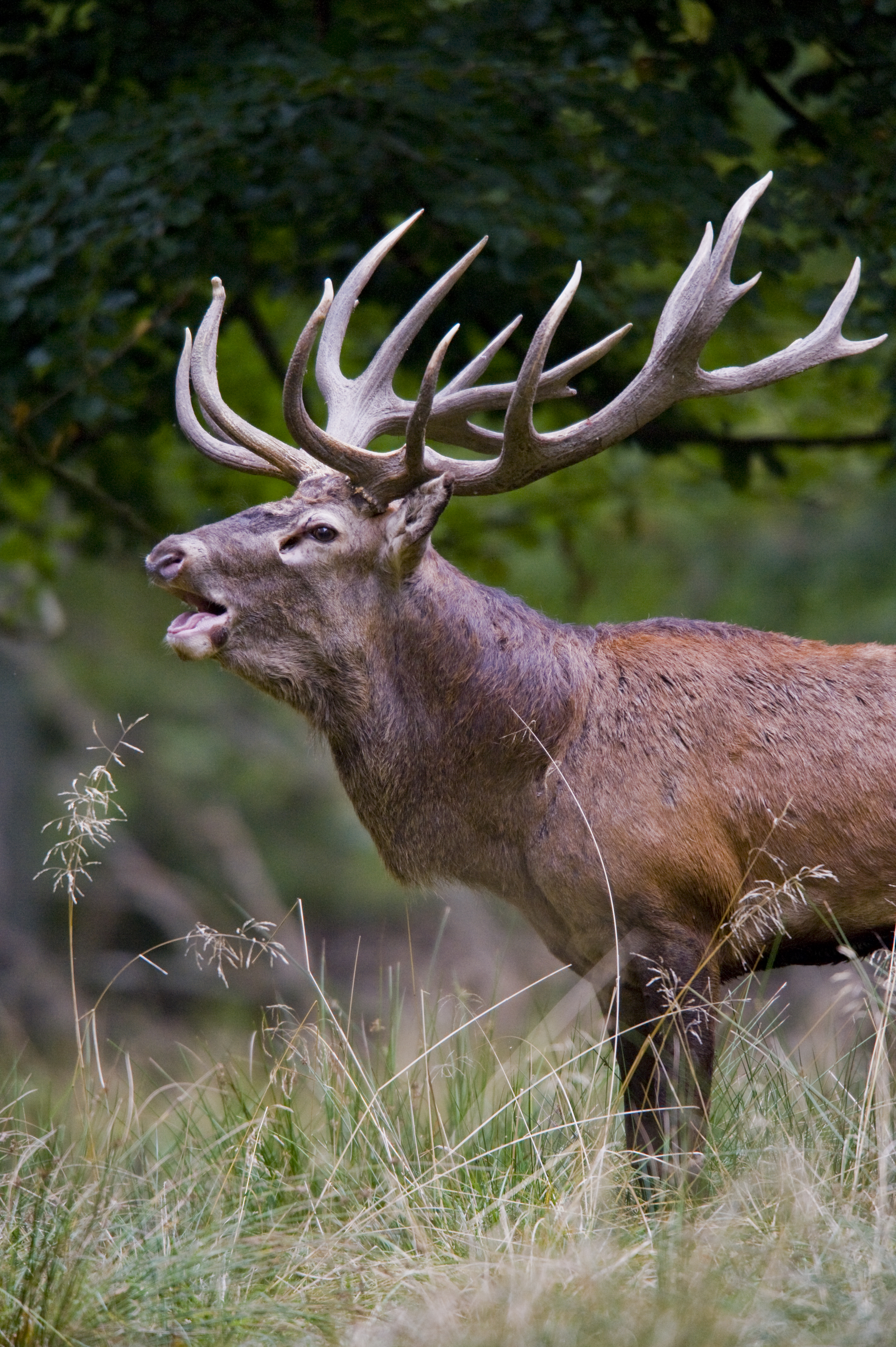|
Estrous
The estrous cycle (, originally ) is a set of recurring physiological changes induced by reproductive hormones in females of mammalian subclass Theria. Estrous cycles start after sexual maturity in females and are interrupted by anestrous phases, otherwise known as "rest" phases, or by Pregnancy (mammals), pregnancies. Typically, estrous cycles repeat until death. These cycles are widely variable in duration and frequency depending on the species.Bronson, F. H., 1989. Mammalian Reproductive Biology. University of Chicago Press, Chicago, IL, USA. Some animals may display bloody vaginal discharge, often mistaken for Menstruation (mammal), menstruation. Many mammals used in commercial agriculture, such as cattle and sheep, may have their estrous cycles artificially controlled with hormonal medications for optimum productivity. The male equivalent, seen primarily in ruminants, is called Rut (mammalian reproduction), rut. Differences from the menstrual cycle Mammals share the same r ... [...More Info...] [...Related Items...] OR: [Wikipedia] [Google] [Baidu] |
Menstruation (mammal)
Menstruation is the shedding of the uterine lining (endometrium). It occurs on a regular basis in uninseminated sexually reproductive-age females of certain mammal species. Although there is some disagreement in definitions between sources, menstruation is generally considered to be limited to primates. It is common in simians (Old World monkeys, New World monkeys, and apes), but completely lacking in strepsirrhine primates and possibly weakly present in tarsiers. Beyond primates, it is known only in bats, the elephant shrew, and the spiny mouse species ''Cairo spiny mouse, Acomys cahirinus''. Overt menstruation (where there is bleeding from the uterus through the vagina) is found primarily in humans and close relatives such as Pan (genus), chimpanzees. Females of other species of Placentalia, placental mammals undergo estrous cycles, in which the endometrium is completely reabsorbed by the animal (covert menstruation) at the end of its Biological life cycle, reproductive cycle. ... [...More Info...] [...Related Items...] OR: [Wikipedia] [Google] [Baidu] |
Endometrium
The endometrium is the inner epithelium, epithelial layer, along with its mucous membrane, of the mammalian uterus. It has a basal layer and a functional layer: the basal layer contains stem cells which regenerate the functional layer. The functional layer thickens and then is shed during menstruation in humans and some other mammals, including other apes, Old World monkeys, some species of bat, the elephant shrew and the Cairo spiny mouse. In most other mammals, the endometrium is reabsorbed in the estrous cycle. During pregnancy, the glands and blood vessels in the endometrium further increase in size and number. Vascular spaces fuse and become interconnected, forming the placenta, which supplies oxygen and nutrition to the embryo and fetus.Blue Histology - Female Reproductive System ... [...More Info...] [...Related Items...] OR: [Wikipedia] [Google] [Baidu] |
Concealed Ovulation
Concealed ovulation or hidden estrus is the lack of any perceptible change (e.g., a change in appearance or scent) when an adult female is fertile and near ovulation. Some examples of perceptible changes are swelling and redness of the vulva in baboons and bonobos, and pheromone release in the feline family. In contrast, the females of humans and a few other species that undergo hidden estrus have few external signs of fecundity, making it difficult for a mate to consciously deduce, by means of external signs only, whether or not a female is near ovulation. Human females In humans, an adult woman's fertility peaks for a few days during each roughly monthly cycle. The frequency and length of fertility (the time when a woman can become pregnant) is highly variable between women, and can slightly change for each woman over the course of her lifespan. Humans are considered to have concealed ovulation because there is no outward physiological sign, either to a woman herself or to o ... [...More Info...] [...Related Items...] OR: [Wikipedia] [Google] [Baidu] |
Mammal
A mammal () is a vertebrate animal of the Class (biology), class Mammalia (). Mammals are characterised by the presence of milk-producing mammary glands for feeding their young, a broad neocortex region of the brain, fur or hair, and three Evolution of mammalian auditory ossicles, middle ear bones. These characteristics distinguish them from reptiles and birds, from which their ancestors Genetic divergence, diverged in the Carboniferous Period over 300 million years ago. Around 6,640 Neontology#Extant taxon, extant species of mammals have been described and divided into 27 Order (biology), orders. The study of mammals is called mammalogy. The largest orders of mammals, by number of species, are the rodents, bats, and eulipotyphlans (including hedgehogs, Mole (animal), moles and shrews). The next three are the primates (including humans, monkeys and lemurs), the Artiodactyl, even-toed ungulates (including pigs, camels, and whales), and the Carnivora (including Felidae, ... [...More Info...] [...Related Items...] OR: [Wikipedia] [Google] [Baidu] |
Menstrual Cycle
The menstrual cycle is a series of natural changes in hormone production and the structures of the uterus and ovaries of the female reproductive system that makes pregnancy possible. The ovarian cycle controls the production and release of eggs and the cyclic release of estrogen and progesterone. The uterine cycle governs the preparation and maintenance of the lining of the uterus (womb) to receive an embryo. These cycles are concurrent and coordinated, normally last between 21 and 35 days, with a median length of 28 days. Menarche (the onset of the first period) usually occurs around the age of 12 years; menstrual cycles continue for about 30–45 years. Naturally occurring hormones drive the cycles; the cyclical rise and fall of the follicle stimulating hormone prompts the production and growth of oocytes (immature egg cells). The hormone estrogen stimulates the uterus lining ( endometrium) to thicken to accommodate an embryo should fertilization occur. The blood suppl ... [...More Info...] [...Related Items...] OR: [Wikipedia] [Google] [Baidu] |
Rage (emotion)
Rage (also known as frenzy or fury) is intense, uncontrolled anger that is an increased stage of hostile response to a perceived egregious injury or injustice. Etymology The word "rage" is from c. 1300, meaning "madness, insanity; a fit of frenzy; rashness, foolhardiness, intense or violent emotion, anger, wrath; fierceness in battle; violence" (of storms, fire, etc.); from the Old French ''rage'' or ''raige'', meaning "spirit, passion, rage, fury, madness"; from 11th-century Medieval Latin ''rabia''; from the Latin ''rabies'', meaning "madness, rage, fury," which is related to the Latin ''rabere'' "be mad, rave." There are many cognates. The Latin ''rabies'', meaning "anger, fury", is akin to the Sanskrit ''raag'' (violence). The Vulgar Latin spelling of the word possesses many cognates when translated into many of the modern Romance languages, such as Spanish, Galician, Catalan, Portuguese, and modern Italian: ''rabia'', ''rabia'', ''ràbia'', ''raiva'', and ''rabbia'' ... [...More Info...] [...Related Items...] OR: [Wikipedia] [Google] [Baidu] |
Progesterone
Progesterone (; P4) is an endogenous steroid and progestogen sex hormone involved in the menstrual cycle, pregnancy, and embryogenesis of humans and other species. It belongs to a group of steroid hormones called the progestogens and is the major progestogen in the body. Progesterone has a variety of important functions in the body. It is also a crucial metabolic intermediate in the production of other endogenous steroids, including the sex hormones and the corticosteroids, and plays an important role in brain function as a neurosteroid. In addition to its role as a natural hormone, progesterone is also used as a medication, such as in combination with estrogen for contraception, to reduce the risk of Uterine cancer, uterine or cervical cancer, in hormone replacement therapy, and in feminizing hormone therapy. It was first prescribed in 1934. Biological activity Progesterone is the most important progestogen in the body. As a potent agonist of the progesterone receptor, nu ... [...More Info...] [...Related Items...] OR: [Wikipedia] [Google] [Baidu] |
Io (mythology)
In Greek mythology, Io (; ) was one of the mortal lovers of Zeus. An Argive princess, she was an ancestor of many kings and heroes, such as Perseus, Cadmus, Heracles, Minos, Lynceus, Cepheus, and Danaus. The astronomer Simon Marius named a moon of Jupiter after Io in 1614. Because her brother was Phoroneus, Io is also known as Phoronis (an adjective form of Phoroneus: "Phoronean"). She was sometimes compared to the Egyptian goddess Isis, whereas her Egyptian husband Telegonus was Osiris. Family In most versions of the legend, Io was the daughter of Inachus, though various other purported genealogies are also known. If her father was Inachus, then her mother would presumably have been Inachus' wife (and sister), the Oceanid nymph Melia, daughter of Oceanus. She had the patronymic Inachis (Ἰναχίς) as daughter of Inachus. Io's father was called Peiren in the ''Catalogue of Women'', and by Acusilaus, possibly a son of the elder Argus, also known as Peiras, Peira ... [...More Info...] [...Related Items...] OR: [Wikipedia] [Google] [Baidu] |
Hera
In ancient Greek religion, Hera (; ; in Ionic Greek, Ionic and Homeric Greek) is the goddess of marriage, women, and family, and the protector of women during childbirth. In Greek mythology, she is queen of the twelve Olympians and Mount Olympus, sister and wife of Zeus, and daughter of the Titans Cronus and Rhea (mythology), Rhea. One of her defining characteristics in myth is her jealous and vengeful nature in dealing with any who offended her, especially Zeus's numerous adulterous lovers and illegitimate offspring. Her iconography usually presents her as a dignified, matronly figure, upright or enthroned, crowned with a ''polos'' or diadem, sometimes veiled as a married woman. She is the patron goddess of lawful marriage. She presides over weddings, blesses and legalises marital unions, and protects women from harm during childbirth. Her sacred animals include the Cattle, cow, cuckoo, and Peafowl, peacock. She is sometimes shown holding a pomegranate as an emblem of immort ... [...More Info...] [...Related Items...] OR: [Wikipedia] [Google] [Baidu] |
Ancient Greek Mythology
Greek mythology is the body of myths originally told by the ancient Greeks, and a genre of ancient Greek folklore, today absorbed alongside Roman mythology into the broader designation of classical mythology. These stories concern the ancient Greek religion's view of the origin and nature of the world; the lives and activities of deities, heroes, and mythological creatures; and the origins and significance of the ancient Greeks' cult and ritual practices. Modern scholars study the myths to shed light on the religious and political institutions of ancient Greece, and to better understand the nature of mythmaking itself. The Greek myths were initially propagated in an oral-poetic tradition most likely by Minoan and Mycenaean singers starting in the 18th century BC; eventually the myths of the heroes of the Trojan War and its aftermath became part of the oral tradition of Homer's epic poems, the ''Iliad'' and the ''Odyssey''. Two poems by Homer's near contemporary Hes ... [...More Info...] [...Related Items...] OR: [Wikipedia] [Google] [Baidu] |
Botfly
Botflies, also known as warble flies, heel flies, and gadflies, are flies of the family Oestridae. Their larvae are internal parasites of mammals, some species growing in the host's flesh and others within the gut. '' Dermatobia hominis'' is the only species of botfly known to parasitize humans routinely, though other species of flies cause myiasis in humans. General A botfly, also written bot fly, bott fly or bot-fly in various combinations, is any fly in the family Oestridae. Their life cycles vary greatly according to species, but the larvae of all species are internal parasites of mammals. Largely according to species, they also are known variously as warble flies, heel flies, and gadflies. The larvae of some species grow in the flesh of their hosts, while others grow within the hosts' alimentary tracts. The word "bot" in this sense means a maggot. A warble is a skin lump or callus such as might be caused by an ill-fitting harness, or by the presence of a warble fly m ... [...More Info...] [...Related Items...] OR: [Wikipedia] [Google] [Baidu] |
Mating Call
A mating call is the auditory signal used by animals to attract mates. It can occur in males or females, but literature is abundantly favored toward researching mating calls in females. In addition, mating calls are often the subject of mate choice, in which the preferences of one gender for a certain type of mating call can drive sexual selection in a species. This can result in sympatric speciation of some animals, where two species diverge from each other while living in the same environment. There are many different mechanisms to produce mating calls, which can be broadly categorized into vocalizations and mechanical calls. Vocalizations are considered as sounds produced by the larynx and are often seen in species of birds, mammals, amphibians, and insects. Mechanical calls refer to any other type of sound that the animal produces using unique body parts and/or tools for communication with potential mates. Examples include Cricket (insect), crickets that vibrate their wings, b ... [...More Info...] [...Related Items...] OR: [Wikipedia] [Google] [Baidu] |









